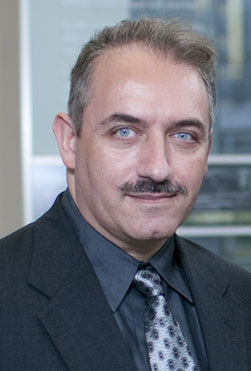- Mailing Address:
- School of Pharmacy
- University of Wisconsin
- 777 Highland Ave.
- Madison, WI 53705
- Office:
- 7113 Rennebohm Hall
- Phone: 608-262-7810
- Fax: 608-262-5345 Email: sandro.mecozzi@wisc.edu
- Pharmaceutical Sciences Division
- Wisconsin Center for NanoBioSystems
- Chemistry Biology Interface Training Grant

Sandro Mecozzi, PhD
Professor
Our research efforts focus on fundamental studies of non-covalent interactions and the application of the resulting findings to biochemical and biomedical problems. We use the predictive value of advanced computational techniques in conjunction with the power of chemical synthesis to generate molecules that are able to recognize each other through intermolecular forces. The study of these complexes allows us to explore a variety of different chemical and biological phenomena. These include the nature of specific intermolecular forces in condensed phase, the origin of the peculiar fluorous phase behavior in highly fluorinated materials and the interaction between short RNAs and small molecules.
The Fluorous Phase
The introduction of fluorine substituents into an organic molecule can radically change the physico-chemical properties of that molecule. High performance materials and polymers, vectors for drug delivery, anesthetics, fluorine-containing drugs, perfluorinated solvents for organic reactions are only a few examples of the practical uses of fluorinated molecules. Extensive perfluorination of organic molecules generates a new phase of liquid matter known as the fluorous phase. This phase does not mix with either polar or non-polar hydrogenated phases. The formation of a fluorous phase is at the basis of the unusual behavior of heavily fluorinated molecules and polymers. While the applications and the uses of fluorinated compounds are constantly increasing, the origin of their unusual properties is currently not completely understood. It is not known what exactly drives the formation of a fluorous phase.
We are currently investigating the nature of the fluorous phase by synthesizing and analyzing several self-assembling fluorinated amphiphilic molecules bearing water solubilizing groups and variously fluorinated functionalities. We are also taking advantage of the large energetics associated with the formation of a fluorous phase to generate thermodynamically stable (micelles) and kinetically stable (nanoemulsions) nanoaggregates that can be used for the efficient and selective intravenous delivery of general anesthetics to the brain. To this purpose, we have designed and synthesized a number of novel, semifluorinated di- and triblock copolymers. The use of specific FDA-approved additives allows us to switch from thermodynamic to kinetically stable aggregates with the corresponding change in the delivery properties of the nanoparticles.
We are also performing molecular dynamics simulations on mixtures involving water, hydrocarbons, and a variety of fluorinated molecules. The purpose of these simulations is to establish first what kind of intermolecular forces can explain the formation of three phases and then identify the minimum number of fluorine atoms that are necessary for generating a fluorous phase.
The Nature of Intermolecular Interactions
We focus our studies on understanding the basic principles behind weak, yet biologically and energetically significant non-covalent forces. Our most recent studies have focused on using the recognition events between enzymes and their inhibitors to study the energetics of specific intermolecular interactions. This approach can be fruitfully used to study a variety of different intermolecular interactions and, at the same time, to achieve a deeper understanding of the enzymes? inner machinery. These experimental studies are complemented by high level ab initio calculations on simple complexes.
Short RNA-Small Molecules Complexes
Our research in this field focuses on finding the minimal RNA sequences able to bind small organic molecules with high selectivity and affinity. Our own approach starts from the analysis of the crystal structure of RNA aptamer?small molecule complexes. We then computationally model these complexes to study the effect of nucleotide deletion and spatial rearrangement on the overall energetics. This approach allows us to computationally design short RNAs that are able to specifically bind small molecules. The complexation thermodynamics is then studied by microdialysis. We are also currently pursuing a dynamic combinatorial approach to this problem.
Background: Prof. Sandro Mecozzi was born and raised in Italy and received a BS/MS from the University of Rome. He received a Ph.D. from the California Institute of Technology in 1996 working with Dennis Dougherty. This was followed by postdoctoral work with Julius Rebek, Jr. at the Scripps Research Institute from 1996 to 1999 where he was a NASA-NSCORT fellow. In the fall of 1999 he joined the faculty of the Division of Pharmaceutical Sciences at the School of Pharmacy, University of Wisconsin-Madison. He currently holds joint appointments in Pharmacy and Chemistry.
Professional Interests: Molecular recognition and non-covalent forces
Education:
- BS - University of Rome
- MS - University of Rome
- PhD 1996 Chemistry - California Institute of Technology
- Postdoctoral - Scripps Research Institute
- Jee, J.-P., Parlato, M.C., Perkins M.G., Mecozzi, S., Pearce, R.A. Exceptionally Stable Fluorous Emulsions for the Intravenous Delivery of Volatile General Anesthetics. Anesthesiology, 2012, 116, 580-585.
- Parlato, M.C., Jee, J.-P., Teshite, M., Mecozzi, S. Synthesis, Characterization, and Applications of hemifluorinated Dibranched Amphiphiles. J. Org. Chem. 2011, 76, 6584-6591.
- Jee, J.-P., McCoy, A., Mecozzi, S. Encapsulation and Release of Amphotericin B from an ABC Triblock Fluorous Copolymer. Pharm. Res. 2011, 29, 69-82
- Johnson R, Simmons K, Fast J, Schroeder C, Pearce R, Albrecht R, Mecozzi S. Histamine release associated with intravenous delivery of a fluorocarbon-based sevoflurane emulsion in canines. J. Pharm. Sci. 2011, 100, 2685-2692.

